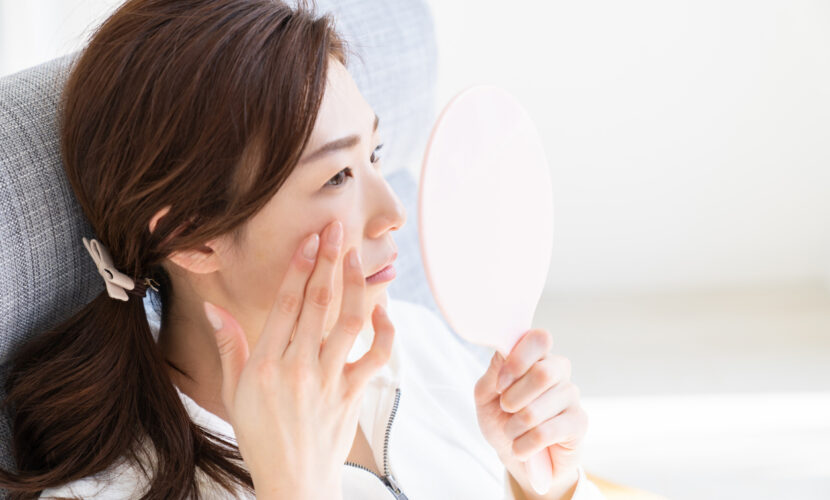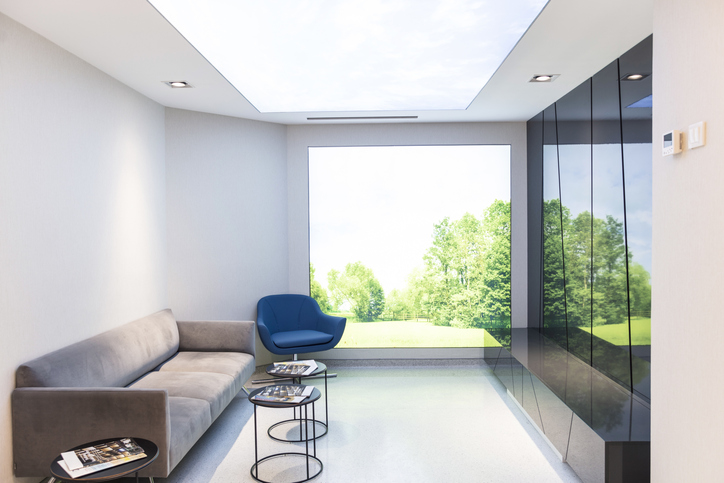Have you ever experienced itchy, itchy, red, or uneven skin that suddenly becomes more noticeable in the spring? Have you ever experienced this? In many cases, what you thought was "dry skin" may actually be rough skin caused by pollen or cold temperatures.
Spring is the season when, in addition to dry air, UV rays, pollen, PM2.5, and other irritants increase all at once. The skin's barrier function is easily disrupted, and delicate problems tend to surface.
Here, we clarify the difference between dry skin and rough skin, while carefully explaining the causes of skin problems that tend to occur in spring and the correct care methods for each symptom. Now is the time to review these tips to break the cycle of recurring problems.

Graduated from the Faculty of Medicine, National Kumamoto University. After serving as the director of major beauty clinics in Japan, etc., he opened Aladdin Aesthetic Clinic in 2023. He is a professional in aesthetic medicine with a doctorate in anti-aging research and many years of experience. With the motto of "Toward the realization of cosmetic medicine without lies," he aims to be the "Only One" together with his patients.
- What Causes Dry and Rough Skin in Spring? A thorough explanation of external and internal factors
- Difference between dry skin and rough skin? Self-check to identify redness, itchiness, and flaky skin.
- To Avoid Repeated Skin Problems! NG habits and skin care basics to review now!
- How to deal with cosmetic skin for dry or rough skin? Guidelines for seeing a doctor and treatment options
- Over-the-counter medications and moisturizers don't help! What are the signs to consider seeing a doctor?
- What are the recommended treatments available at cosmetic dermatology clinics? Introduction of effective menu for dry and rough skin
- Don't make medical care a "last resort"! Why you should feel free to consult with us more easily
- summary
What Causes Dry and Rough Skin in Spring? A thorough explanation of external and internal factors
Does your skin become tight, red, or show small bumps of irritation with the onset of spring? It is not uncommon; many people experience skin problems in the spring.
So why do "dry skin" and "rough skin" worsen during this season? The answer lies in both the external environment unique to spring and the minute changes occurring inside the skin.
Pollen, temperature differences, UV rays, and other external factors in spring are a constant challenge for the skin.
Spring is a season of unstable temperatures and large temperature differences. It is cold in the morning, but by noon, it is so warm that it makes you sweat... The temperature fluctuates greatly throughout the day. This environment is a major factor in lowering the skin's barrier function.
In addition, while the skin is still recovering from the dryness of winter, UV rays intensify and irritants in the air such as pollen, yellow sand, and PM2.5 increase. Skin is exposed to external stimuli at all hours of the day.
Skin with impaired barrier function is more likely to be hypersensitive to irritation, causing reactions such as redness, itching, and eczema. This is due to the skin's stratum corneum not retaining sufficient moisture and not being able to act as a "shield" to prevent foreign substances from the outside.
| External factors that increase in spring | Main effects on skin |
|---|---|
| Pollen, yellow sand, PM2.5 | Allergic reactions, itching, boils |
| ultra-violet rays | Activation of melanin production and aggravation of dryness |
| difference in temperature | Poor blood circulation and sebum imbalance |
| Dry air | Moisture evaporation in stratum corneum and deterioration of barrier function |
The combined effect of these factors causes spring skin to become more delicate than usual.
Why do pollen and PM2.5 irritate the skin?
It is often said that "airborne pollution is bad for the skin," but why does the skin react so badly to it? Fine particles such as pollen and PM2.5 adhere to the surface of the skin while suspended in the air. These particles are invisible to the naked eye, but they are extremely fine and have the characteristic of easily entering pores and sweat glands.
These ingredients, including allergens and toxic substances, then stimulate the skin's immune system, causing an inflammatory response as "foreign substances" invade the skin. Skin that is dry and defenseless is particularly vulnerable to this effect.
PM2.5 also contains heavy metals and exhaust gases, which create oxidative stress and cause skin aging and dullness. Spring skin is not only dry, but also battles these "invisible contaminants" on a daily basis.
Stress and lifestyle disorders can also spark skin problems.
In addition to external stimuli, the skin is also sensitive to internal influences. Spring is a time of new life and environmental changes, and mental stress tends to increase. An imbalance in the autonomic nervous system due to lack of sleep, disordered eating habits, and tension can upset the regulation of skin turnover and sebum secretion, reducing the skin's ability to recover.
In addition, stress is known to cause an overproduction of a hormone called "cortisol" in the skin, which can trigger inflammation. Even if you take good care of your skin, if your lifestyle is disordered, your skin will not function properly as it should.
Difference between dry skin and rough skin? Self-check to identify redness, itchiness, and flaky skin.
We have already told you in the previous chapter that the spring air creates a harsh environment for the skin. However, there is more than one reason why the skin reacts. The same redness may be caused by dryness for one person and the beginning of an allergic reaction for another.
So which type of skin disorder are you experiencing? Here we will explain in detail how to identify the symptoms, while unraveling the differences between terms such as "dry skin," "rough skin," and "sensitive skin.
What is the definition of similar but different skin problems: dry skin, rough skin, and sensitive skin?
First, let's clarify the essence of each of the three words, which are often confused.
Dry skin is a condition in which the stratum corneum loses its ability to retain moisture and the skin is unable to retain moisture. Powdery or tight feeling is the main cause of lack of moisture.
Rough skin is a condition in which the skin is irritated not only by dryness but also by various irritants such as friction, UV rays, pollen, and stress. In many cases, it is accompanied by redness, itching, and a burning sensation.
Sensitive skin is a term used to describe "the tendency of the skin to overreact to external stimuli. This is not a temporary condition and tends to be influenced by the skin's underlying constitution and living environment.
Although they may seem similar, they have different causes and different ways of dealing with them, so there is a risk of worsening the condition if skin care is left confused.
Determine your skin's "now" by its symptoms
Because skin problems are visible phenomena, we tend to think we can figure them out. However, there is a big difference between the same "itchiness" or "redness" and whether it is caused by dryness or allergic inflammation.
Take a cool look at your skin condition with the following checkpoints.
| symptoms | Common signs of dry skin | Common signs of skin irritation |
|---|---|---|
| blush | Tends to appear after washing face or when lack of moisturizer. | Often sudden and localized on the cheeks and chin |
| itch | Easily aggravated when air is dry | Tendency to intensify after contact with pollen and dust |
| Boils and pimples | Little or no keratin ridge due to dryness | Small inflammations or eczema-like granulations may appear. |
| Feeling of tightness and powdering | Cheeks, mouth, and eye areas are especially tight. | Some, but overall inflammatory symptoms predominate |
| make-up paste | Easily uneven and does not adhere to the skin | Prone to breakdown due to skin irregularities and irritation |
While there are certain trends in how each symptom appears, it is the "compound" type of trouble that requires the most attention. For example, pollen may come into contact with a weakened barrier function due to continuous dryness, leading to allergic inflammation, so it is important to carefully observe the symptoms without assuming "one or the other.
What do you do about skin problems that won't heal or get worse?
Skin has the natural ability to regenerate itself in a 28-day cycle. Mild dryness or temporary irritation usually settles down within a few days to a week. However, if the redness, itching, or bumps persist for more than two weeks or get worse with each passing day, it is necessary to move away from self-judgment.
You may consider seeing a dermatologist or cosmetic dermatologist, especially in the following cases
- Redness and itching so severe that it interferes with daily life
- No signs of improvement with commercial skin care
- In addition to inflammation, the skin is peeling and jiggly.
- Not improving over a period of time, but rather worsening
Self-initiated skin care can sometimes have the opposite effect of what you intend to do. Please remember that "giving your skin a break" and "seeking professional advice" are important options for skin care.
To Avoid Repeated Skin Problems! NG habits and skin care basics to review now!
Once you are able to determine the condition of your skin and the cause of your skin problems, the next thing you want to face is your daily habits. Dry skin and rough skin are not caused by external stimuli or physical constitution alone.
Unconscious habits hidden in our daily skin care and lifestyle may be damaging our skin. In particular, there are many cases where well-meaning care actually hinders the skin's recovery.
Here we will take a deeper look at the pitfalls of skin care and lifestyle habits that should be reviewed in order to avoid recurring dry or rough skin.
Be careful not to over-wash or over-apply! Review the starting point of proper cleansing and moisturizing.
Surprisingly, many people report skin problems such as "My skin feels rough even though I wash my face thoroughly" or "My skin feels dry even though I use a highly moisturizing lotion. It is wonderful to be aware of the need to cleanse and moisturize the skin, but if you do it wrong, you can end up putting more stress on the skin than you should.
For example, do you use hot water to wash your face, double-cleanse your face every morning and evening, or apply lather in a scrubbing manner? All of these things can damage the stratum corneum and break down the barrier function.
The same is true for moisturizing, and in some cases, applying excessive layers of lotion or seeking temporary coolness with ethanol-containing cosmetics actually results in the skin's internal inability to retain moisture, and the dryness becomes chronic.
| NG Habits | Adverse effects on the skin |
|---|---|
| Washing face with too hot water | Deprives sebum, causing dryness and redness |
| Strong cleansing cleansers and soaps | Destroys the barrier function and skin irritation becomes chronic. |
| Extensive use of lotion with ethanol | Irritating and creates the illusion of temporary moisture |
| Excessive application of milky lotions and creams | Induce other problems such as clogged pores, shine, acne, etc. |
The basis of skin care is not to wash too much and not to protect too much. Leaving the necessary sebum and gently protecting it is the first step toward recovery from dry or rough skin.
Is exfoliation such as peeling and scrubbing really necessary?
When skin feels rough or pores feel clogged, many people turn to exfoliators such as "peels" and "scrubs. However, using such items in the midst of rough skin or during times of severe dryness may result in skin regeneration being hindered.
The stratum corneum is a natural barrier that protects the skin. It is true that sometimes old keratin remains on the skin due to a disorder of turnover, but physically removing it leaves the skin in an even more vulnerable state. It is precisely when the skin is sensitive that the courage to do nothing should also be valued.
Especially in spring, when UV radiation levels begin to rise sharply. Adding peeling and strong massages to this process can amplify the damage to the skin many times over.
Skin health begins with a well-organized lifestyle.
No matter how expensive your beauty products are, if you are not getting enough sleep and eating convenience foods every day, your skin will not regain its natural ability to repair itself. The skin is a part of the body and is like a mirror that reflects the condition of the whole body.
Especially during sleep, growth hormone is secreted and skin repair is activated. Staying up late at night interferes with this function and reduces the skin's ability to recover. In addition, a diet that is biased toward carbohydrates, lack of vegetables, and lack of protein can lead to a lack of nutrients that support the skin's structure itself.
In addition, stress not only lowers the immune function of the skin, but also causes hormonal imbalance and deterioration of the intestinal environment, which aggravates rough skin. The root cause of skin problems can be solved not only by external care, but also by daily care for oneself.
How to deal with cosmetic skin for dry or rough skin? Guidelines for seeing a doctor and treatment options
Skin care has been reviewed and lifestyle changes have been made. Nevertheless, the skin irritation still does not subside, and redness and itching due to dryness may recur. At such times, many people may wonder, "Is it really necessary to go to a hospital just for this?" Many people may wonder, "Is it really necessary to go to a hospital for this level of skin irritation?
However, there may be "medical factors" lurking behind prolonged dry or rough skin that cannot be reached by self-care. Let's take a careful look at when to see a cosmetic dermatologist and the treatment options available.
Over-the-counter medications and moisturizers don't help! What are the signs to consider seeing a doctor?
Skin has a mechanism that originally recovers on its own and is renewed in a certain cycle. Mild dryness and inflammation can often be corrected with proper care and lifestyle changes. However, if the following symptoms persist, it may be a sign that medical intervention is needed.
- Redness on cheeks that does not heal with moisturizing and lasts for more than a week
- Itching is so severe that it is scratched and turns into bleeding and eczema.
- Repeated inflammation and hyperpigmentation of the skin began to be noticeable.
- The acne has not improved and the use of cosmetics has become difficult.
In these cases, not only changes occurring on the skin's surface, but also inflammatory reactions deep within the skin and the body may be affected, requiring medical attention.
What are the recommended treatments available at cosmetic dermatology clinics? Introduction of effective menu for dry and rough skin
When rough or dry skin does not improve, cosmetic dermatology offers a wide range of options for fundamental skin quality improvement that are not "stopgap measures. Below is a menu of recommended treatments, especially for those suffering from springtime skin problems and a decline in the barrier function.
| Name of treatment | Features and Benefits | Suitable Symptoms |
|---|---|---|
| ion implantation | Delivers vitamin C, tranexamic acid, and other substances to the deeper layers of the skin with a weak electric current. Effective in reducing inflammation and strengthening the skin barrier. | Redness, mild skin irritation, dryness, dullness |
| electroporation | Penetrates beauty ingredients into the interior of the skin without the use of needles. It can both moisturize and soothe, and is easy to undergo even during sensitive periods. | Sensitive skin, dry skin, mild irritation |
| laser toning | Low-irritation laser treatment to improve melanin and post-inflammatory hyperpigmentation. It is suitable for red faces and recurring skin irritations. | Pigmentation, redness, chronic skin problems |
| dermapen | A treatment that stimulates the skin with fine needles to promote regeneration. It is also effective in treating texture disorders and pores caused by dryness. | Stiff skin, visible pores, slow recovery |
| peeling | Gently remove unwanted keratin using salicylic acid or lactic acid. If performed during a period when there is no inflammation, turnover can be normalized. | Stiffness, mild dryness, reduced transparency |
These procedures have in common that they approach deeper areas of the skin that cannot be reached by skin care. In addition, since the choice of treatment depends on the condition of the skin, it is important to consult with a physician without difficulty.
When you feel that cosmetics alone are not enough, it is time to open the door to cosmetic medicine. What your skin needs is the right knowledge and a boost from a trusted professional.
Don't make medical care a "last resort"! Why you should feel free to consult with us more easily
The image of "going to a hospital is a last resort" may still persist. However, the role of cosmetic dermatology is not "just treatment," but "medical support to improve the skin's basic strength.
For example, for recurring dry skin, moisturizers, steroids, and anti-allergy medications, which can only be prescribed by a medical institution, can help overcome the acute phase of symptoms. After the inflammation subsides, laser, phototherapy, and induction therapy are options to improve the foundation of the skin itself.
For those who have skin problems, cosmetic dermatologists should be positioned not as a "run-in" but as a companion to help them continue to deal with their skin.
Even if the cause of dry or rough skin is not clear, there is great significance in consulting with a doctor as soon as you feel "concerned. Without hesitation, utilize the power of medical treatment in a more casual and positive manner. This is the most valuable step you can take for your future skin.
summary
Dry or rough skin is not just a temporary problem, but is caused by a complex relationship between the external environment surrounding the skin, daily lifestyle, and skin care methods. In particular, spring is the season when external stimuli such as pollen and cold temperature differences are more intense and the skin's barrier function is more easily shaken, making symptoms more likely to appear.
The important thing is to correctly understand the condition and causes of your skin, and to take care of it accordingly. Facing your skin throughout the year and reviewing your care according to changes is a sure step toward "skin that won't repeat itself.
At Aladdin Aesthetic Clinic, based on our many years of experience in cosmetic medicine and cosmetic dermatology and the knowledge of our doctoral degree, we provide counseling that aims to be "only one", offering the best treatment for each person we meet. We offer only the necessary treatments without any unnecessary information or suggestions.
Feel free to use our official LINE account for 24-hour counseling and reservations. Please feel free to contact us for free counseling for the first time or if you have any concerns.






